#black klansman
Photo



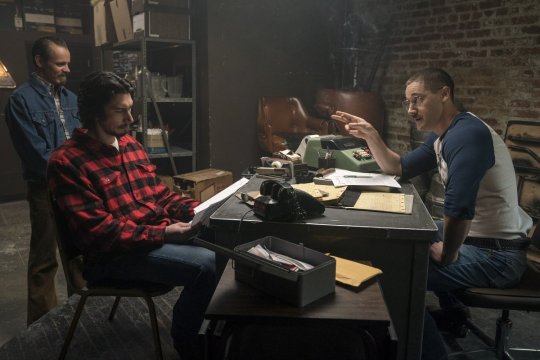


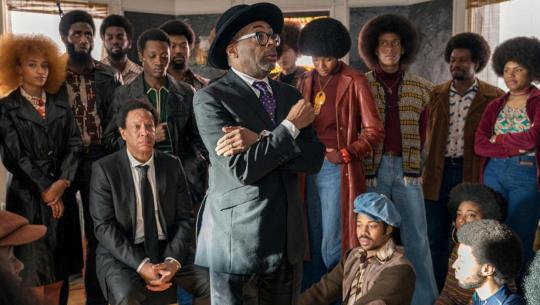

BlacKkKlansman (2018) Spike Lee
January 20th 2023
#blackkklansman#2018#spike lee#john david washington#adam driver#laura harrier#jasper pääkkönen#ryan eggold#paul walter hauser#robert john burke#topher grace#ken garito#frederick weller#michael buscemi#ashlie atkinson#harry belafonte#black klansman
49 notes
·
View notes
Photo
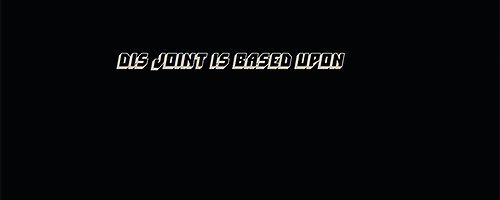
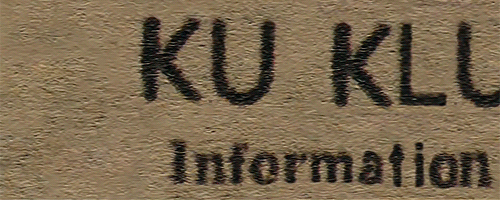

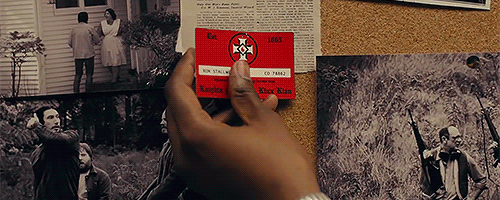



365 Movies Challenge #273; Black Klansman (2018) dir. Spike Lee:
“They want a black man to join the Ku Klux Klan. I'd say that's Mission Impossible. Double Success! We're in!” | “I'm Jewish, but I wasn't raised to be. It wasn't part of my life, I never thought much about being Jewish, nobody around me was Jewish. I wasn't going to a bunch of Bar Mitzvahs, I didn't have a Bar Mitzvah. I was just another white kid. And now I'm in some basement denying it out loud. *chuckles* I never thought much about it, now I'm thinking about it all the time. About rituals and heritage. Is that passing? Well then I have been passing.”
#365 movies challenge#365 movie challenge#black klansman#spike lee#john david washington#moviegifs#gif#mine#made by me#photoset#gifs#gifset
66 notes
·
View notes
Text

22.02.2023
After the disappointment of yesterday, something English again
3 notes
·
View notes
Text
I really truly don't understand people who say that reading nonfiction is too difficult or boring. you don't have to read textbooks. there are TONS of nonfiction books that are incredibly interesting and told in a familiar narrative style
#the only nonfiction ive encountered thats more difficult to read than fiction books are books written for people in that field#just find nonfiction books for laypeople. thats like most of the nonfiction books that are published#nontiction is probably like 75-80% of what i read cause its cool as hell#just finished confidence man and black klansman now reading the most dangerous man in america and conspiracy by michael shermer#anyway poke around the nonfiction section of ur librarys physical or digital collection#guarantee youll find something you can enjoy
21 notes
·
View notes
Text
not to talk about superhero shit, but I genuinely felt like I was losing my mind when everyone kept talking about how good that watchman show was. my aunt had me watch it once when I was over at her house cause she knew I liked comics and it took everything within me not to chew the screen
#remember how they made the klansman superhero who was a sadomasochist#who only joined/became a vigilante bc he liked being beat up/beating other people up#and they made him a black man who survived a lynching. which has terrible implications
2 notes
·
View notes
Photo
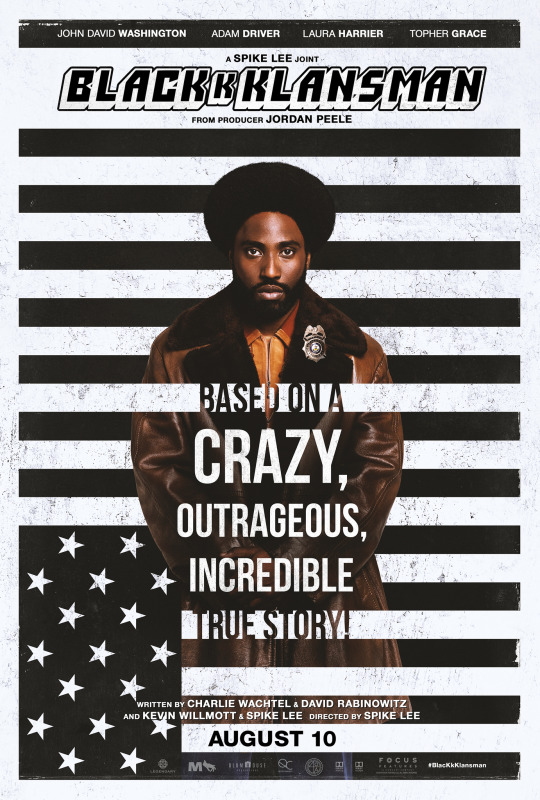
#john david washington#the black klansman#the blackkklansman#movie poster#adam driver#spike lee#jordan peele#topher grace#laura harrier#movie posters#film#charlie wachtel#david rabinowitz#kevin willmott#movies
8 notes
·
View notes
Text

Burn in hell Motherfucker.
#The only good klansman is a dead klansman#Because there is no such thing as a good klansman#heartbreaking 💔#black lives matter#important#tw: discrimination#true crime#topic: discrimination#tw: oppression#youtube#topic: oppression#blm#blue lives don't matter#blue lives dont exist#black lives movement#black lives have always mattered#black lives are important#black lives fucking matter#blue lives matter#stop police brutality#blue lives murder#Youtube#police brutality#defund the cops#defund 12#defund police#tw: racist#topic: racism#topic: racist#tw: racism
3 notes
·
View notes
Text
.
#stuck reading black klansman for my English exam which yes while being a very interesting book is not exactly what I want to binge rn#I kinda want to binge that 200+k shadowgast fic I started last night which kept awake til 3 am#haven't read fics in like a year and this one's just so good#I also already know how black klansman ends cause I watched the movie#maybe if I hadnt I would be more motivated to keep reading cause it's a good book but it lacks the suspense for me#anyway. c ya#p
0 notes
Text
Ian Millhiser at Vox:
The Supreme Court announced on Monday that it will not hear Mckesson v. Doe. The decision not to hear Mckesson leaves in place a lower court decision that effectively eliminated the right to organize a mass protest in the states of Louisiana, Mississippi, and Texas.
Under that lower court decision, a protest organizer faces potentially ruinous financial consequences if a single attendee at a mass protest commits an illegal act.
It is possible that this outcome will be temporary. The Court did not embrace the United States Court of Appeals for the Fifth Circuit’s decision attacking the First Amendment right to protest, but it did not reverse it either. That means that, at least for now, the Fifth Circuit’s decision is the law in much of the American South.
For the past several years, the Fifth Circuit has engaged in a crusade against DeRay Mckesson, a prominent figure within the Black Lives Matter movement who organized a protest near a Baton Rouge police station in 2016.
The facts of the Mckesson case are, unfortunately, quite tragic. Mckesson helped organize the Baton Rouge protest following the fatal police shooting of Alton Sterling. During that protest, an unknown individual threw a rock or similar object at a police officer, the plaintiff in the Mckesson case who is identified only as “Officer John Doe.” Sadly, the officer was struck in the face and, according to one court, suffered “injuries to his teeth, jaw, brain, and head.”
Everyone agrees that this rock was not thrown by Mckesson, however. And the Supreme Court held in NAACP v. Claiborne Hardware (1982) that protest leaders cannot be held liable for the violent actions of a protest participant, absent unusual circumstances that are not present in the Mckesson case — such as if Mckesson had “authorized, directed, or ratified” the decision to throw the rock.
Indeed, as Justice Sonia Sotomayor points out in a brief opinion accompanying the Court’s decision not to hear Mckesson, the Court recently reaffirmed the strong First Amendment protections enjoyed by people like Mckesson in Counterman v. Colorado (2023). That decision held that the First Amendment “precludes punishment” for inciting violent action “unless the speaker’s words were ‘intended’ (not just likely) to produce imminent disorder.”
The reason Claiborne protects protest organizers should be obvious. No one who organizes a mass event attended by thousands of people can possibly control the actions of all those attendees, regardless of whether the event is a political protest, a music concert, or the Super Bowl. So, if protest organizers can be sanctioned for the illegal action of any protest attendee, no one in their right mind would ever organize a political protest again.
Indeed, as Fifth Circuit Judge Don Willett, who dissented from his court’s Mckesson decision, warned in one of his dissents, his court’s decision would make protest organizers liable for “the unlawful acts of counter-protesters and agitators.” So, under the Fifth Circuit’s rule, a Ku Klux Klansman could sabotage the Black Lives Matter movement simply by showing up at its protests and throwing stones.
The Fifth Circuit’s Mckesson decision is obviously wrong
Like Mckesson, Claiborne involved a racial justice protest that included some violent participants. In the mid-1960s, the NAACP launched a boycott of white merchants in Claiborne County, Mississippi. At least according to the state supreme court, some participants in this boycott “engaged in acts of physical force and violence against the persons and property of certain customers and prospective customers” of these white businesses.
Indeed, one of the organizers of this boycott did far more to encourage violence than Mckesson is accused of in his case. Charles Evers, a local NAACP leader, allegedly said in a speech to boycott supporters that “if we catch any of you going in any of them racist stores, we’re gonna break your damn neck.”
With SCOTUS refusing to take up McKesson v. Doe, the 5th Circuit's insane anti-1st Amendment ruling that effectively bans mass protests remains in force for the 3 states covered in the 5th: Texas, Louisiana, and Mississippi.
#SCOTUS#Deray McKesson#Protests#Black Lives Matter#5th Circuit Court#Texas#Louisiana#Mississippi#1st Amendment#Counterman v. Colorado#NAACP v. Claiborne Hardware#McKesson v. Doe
218 notes
·
View notes
Text


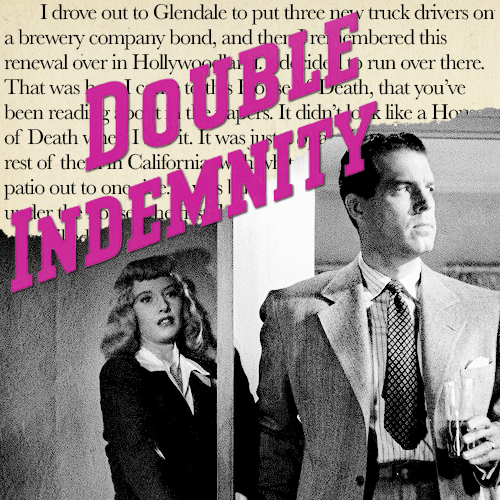




@pscentral event 18: adaptations
↳ favorite crime film adaptations
L.A. CONFIDENTIAL (1997) // L.A. Confidential by James Ellroy
THE NICE GUYS (2016) // Blue Murder by Brett Halliday
DOUBLE INDEMNITY (1944) // Double Indemnity by James M. Cain
INHERENT VICE (2014) // Inherent Vice by Thomas Pynchon
BLACKkKLANSMAN (2018) // Black Klansman by Ron Stallworth
GUN CRAZY (1950) // "Gun Crazy" by MacKinlay Kantor
JACKIE BROWN (1997) // Rum Punch by Elmore Leonard
#tuserheidi#userrobin#userraffa#tuserjen#userrin#singinprincess#userlosthaven#usertj#tuserhan#usergina#userlenny#dailyflicks#filmgifs#fyeahmovies#cinematv#film#compilation#mine#my gifs#events
432 notes
·
View notes
Text
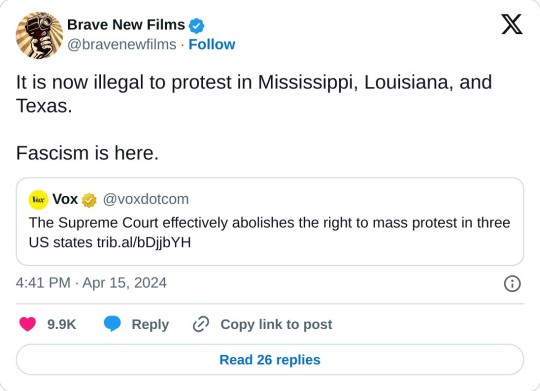


Under that lower court decision, a protest organizer faces potentially ruinous financial consequences if a single attendee at a mass protest commits an illegal act.
It is possible that this outcome will be temporary. The Court did not embrace the United States Court of Appeals for the Fifth Circuit’s decision attacking the First Amendment right to protest, but it did not reverse it either. That means that, at least for now, the Fifth Circuit’s decision is the law in much of the American South.
For the past several years, the Fifth Circuit has engaged in a crusade against DeRay Mckesson, a prominent figure within the Black Lives Matter movement who organized a protest near a Baton Rouge police station in 2016.
The facts of the Mckesson case are, unfortunately, quite tragic. Mckesson helped organize the Baton Rouge protest following the fatal police shooting of Alton Sterling. During that protest, an unknown individual threw a rock or similar object at a police officer, the plaintiff in the Mckesson case who is identified only as “Officer John Doe.” Sadly, the officer was struck in the face and, according to one court, suffered “injuries to his teeth, jaw, brain, and head.”
Everyone agrees that this rock was not thrown by Mckesson, however. And the Supreme Court held in NAACP v. Claiborne Hardware (1982) that protest leaders cannot be held liable for the violent actions of a protest participant, absent unusual circumstances that are not present in the Mckesson case — such as if Mckesson had “authorized, directed, or ratified” the decision to throw the rock.
Indeed, as Justice Sonia Sotomayor points out in a brief opinion accompanying the Court’s decision not to hear Mckesson, the Court recently reaffirmed the strong First Amendment protections enjoyed by people like Mckesson in Counterman v. Colorado (2023). That decision held that the First Amendment “precludes punishment” for inciting violent action “unless the speaker’s words were ‘intended’ (not just likely) to produce imminent disorder.”
The reason Claiborne protects protest organizers should be obvious. No one who organizes a mass event attended by thousands of people can possibly control the actions of all those attendees, regardless of whether the event is a political protest, a music concert, or the Super Bowl. So, if protest organizers can be sanctioned for the illegal action of any protest attendee, no one in their right mind would ever organize a political protest again.
Indeed, as Fifth Circuit Judge Don Willett, who dissented from his court’s Mckesson decision, warned in one of his dissents, his court’s decision would make protest organizers liable for “the unlawful acts of counter-protesters and agitators.” So, under the Fifth Circuit’s rule, a Ku Klux Klansman could sabotage the Black Lives Matter movement simply by showing up at its protests and throwing stones.
84 notes
·
View notes
Note
what is going on in your anons rn……………….. 😭
transmisogynist black dude made a post about me re someone elses speculation that aaron bushnell may not have been cis and now his followers are in my inbox calling me a klansman
63 notes
·
View notes
Text
definitely a longer piece so these excerpts are far from showcasing everything this piece has to offer! read the whole thing on your own time, and in general, just check out jewish currents, an educational, leftist, anti-zionist jewish magazine!
Every August, the township of Edison, New Jersey—where one in five residents is of Indian origin—holds a parade to celebrate India’s Independence Day. In 2022, a long line of floats rolled through the streets, decked out in images of Hindu deities and colorful advertisements for local businesses. People cheered from the sidelines or joined the cavalcade, dancing to pulsing Bollywood music. In the middle of the procession came another kind of vehicle: A wheel loader, which looks like a small bulldozer, rumbled along the route bearing an image of Indian Prime Minister Narendra Modi aloft in its bucket.
For South Asian Muslims, the meaning of the addition was hard to miss. A few months earlier, during the month of Ramadan, Indian government officials had sent bulldozers into Delhi’s Muslim neighborhoods, where they damaged a mosque and leveled homes and storefronts. The Washington Post called the bulldozer “a polarizing symbol of state power under Narendra Modi,” whose ruling Bharatiya Janata Party (BJP) is increasingly enacting a program of Hindu supremacy and Muslim subjugation. In the weeks after the parade, one Muslim resident of Edison, who is of Indian origin, told The New York Times that he understood the bulldozer much as Jews would a swastika or Black Americans would a Klansman’s hood. Its inclusion underscored the parade’s other nods to the ideology known as Hindutva, which seeks to transform India into an ethnonationalist Hindu state. The event’s grand marshal was the BJP’s national spokesperson, Sambit Patra, who flew in from India. Other invitees were affiliated with the Hindu Swayamsevak Sangh (HSS), the international arm of the Hindu nationalist paramilitary force Rashtriya Swayamsevak Sangh (RSS), of which Modi is a longtime member.
...
On December 6th, 1992, a mob of 150,000 Hindus, many of whom were affiliated with the paramilitary group the RSS, gathered at the Babri Masjid, a centuries-old mosque that is one of the most contested sacred sites in the world. Over the preceding century, far-right Hindus had claimed that the mosque, located in the North Indian city of Ayodhya, was built not only upon the site where the Hindu deity Ram was born but atop the foundations of a demolished Hindu temple. The RSS and its affiliates had been campaigning to, in the words of a BJP minister, correct the “historical mistake” of the mosque’s existence, a task the mob completed that December afternoon. “They climbed on top of the domes and tombs,” one witness told NPR. “They were carrying hammers and these three-pronged spears from Hindu scripture. They started hacking at the mosque. By night, it was destroyed.” The demolition sparked riots that lasted months and killed an estimated 2,000 people across the country.
The destruction of the Babri Masjid was arguably Hindu nationalism’s greatest triumph to date. Since its establishment in 1925, the RSS—whose founders sought what one of them called a “military regeneration of the Hindus,” inspired by Mussolini’s Black Shirts and Nazi “race pride”—had been a marginal presence in India: Its members held no elected office, and it was temporarily designated a terrorist organization after one of its affiliates shot and killed Mohandas Gandhi in 1948. But the leveling of the Babri Masjid activated a virulently ethnonationalist base and paved the way for three decades of Hindutva ascendance. In 1998, the BJP formed a government for the first time; in 2014, it returned to power, winning a staggering 282 out of 543 seats in parliament and propelling Modi into India’s highest office. Since then, journalist Samanth Subramanian notes, all of the country’s governmental and civil society institutions “have been pressured to fall in line” with a Hindutva agenda—a phenomenon on full display in 2019, when the Supreme Court of India awarded the land where the Babri Masjid once stood to a government run by the very Hindu nationalists who illegally destroyed it. (Modi has since laid a foundation stone for a new Ram temple in Ayodhya, an event that a prominent RSS activist celebrated with a billboard in Times Square.) The Ayodhya verdict came in the same year that Modi stripped constitutional protections from residents of the Muslim-majority region of Kashmir and passed a law that creates a fast track to citizenship for non-Muslim immigrants, laying the groundwork for a religious test for Indian nationality. Under Modi, “the Hinduization of India is almost complete,” as journalist Yasmeen Serhan has written in The Atlantic.
To achieve its goals, the RSS has worked via a dense network of organizations that call themselves the “Sangh Parivar” (“joint family”) of Hindu nationalism. The BJP, which holds more seats in the Indian parliament than every other party combined, is the Sangh’s electoral face. The Vishwa Hindu Parishad (VHP) is the movement’s cultural wing, responsible for “Hinduizing” Indian society at the grassroots level. The Bajrang Dal is the project’s militant arm, which enforces Hindu supremacy through violence. Dozens of other organizations contribute money and platforms to the Sangh. The sheer number of groups affords the Sangh what human rights activist Pranay Somayajula has referred to as a “tactical politics of plausible deniability,” in which the many degrees of separation between the governing elements and their vigilante partners shields the former from backlash. This explains how, until 2018, the CIA could describe the VHP and Bajrang Dal as “militant religious organizations”—a designation that applies to non-electoral groups exerting political pressure—even as successive US governments have maintained a warm relationship with their parliamentary counterpart, the BJP.
...
The most extreme figures in the Hindu nationalist and Zionist movements were especially frank about the nature of their partnership: “Whether you call them Palestinians, Afghans, or Pakistanis, the root of the problem for Hindus and Jews is Islam,” Bajrang Dal affiliate Rohit Vyasmaan told The New York Times of his friendly relationship with Mike Guzofsky, a member of a violent militant group connected to the infamous Jewish supremacist Meir Kahane’s Kach Party.
...
In 2003, Gary Ackerman—a Jewish former congressman who was awarded India’s third-highest civilian honor for helping to found the Congressional Caucus on India—told a gathering of AJC and AIPAC representatives and their Indian counterparts that “Israel [is] surrounded by 120 million Muslims,” while “India has 120 million [within].” Tom Lantos, another Jewish member of the caucus, likewise enjoined the two communities to collaborate: “We are drawn together by mindless, vicious, fanatic, Islamic terrorism.”
#reaux speaks#hindutva#nationalism#islam#religion#india#narendra modi#south asia#muslim#new jersey#Bharatiya Janata Party#history#resources#jewish currents#anti zionism#palestine#islamophobia#afghanistan#hindu#jewish#free palestine#israel
159 notes
·
View notes
Text
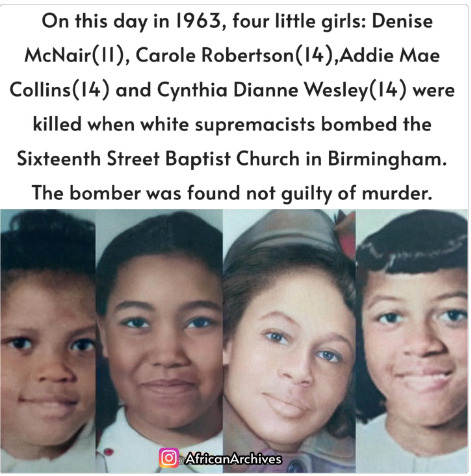
On this day in 1963, a white man detonated a bomb under the steps of the Sixteenth Street Baptist Church in Birmingham, Alabama, with 400 congregants inside—4 Black children were killed in the blast.
The bomber, klansman Robert "Dynamite Bob" Chambliss was found not guilty of murder. He was given a $100 fine and 6 months in jail for having dynamite.
14 years later, Chambliss was found guilty of the murders when the trial was reopened.
140 notes
·
View notes
Text
I have 115 titles in my "to listen to" tag on Libby 😩 how in the fuck am I gonna listen to all of these books?? they range from 4-28 hours long 😭😭
#almost gives me panic attacks picking my mext book bc i want to listen to all of them!!!!!#just finished you just need to lose weight and 19 other myths about fat people by aubrey gordon (highly recommend)#almost done with stamped by ibram x kendi and jason reynolds#think im gonna listen to black klansman by ron stallworth bc its only 6 hours#but i really want to listen to this 22 hour malcolm x biography and a 26 hour watergate book. im gonna DIE#how can i listen to shit about richard nixon for 22 hrs. i have another nixon book thats 14 hrs so i might do that first to prepare#but god thats a lot of Nixon
8 notes
·
View notes
Text



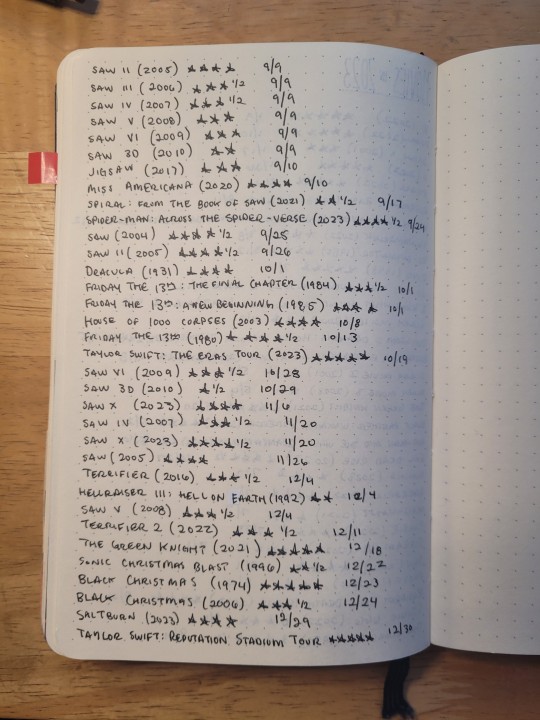
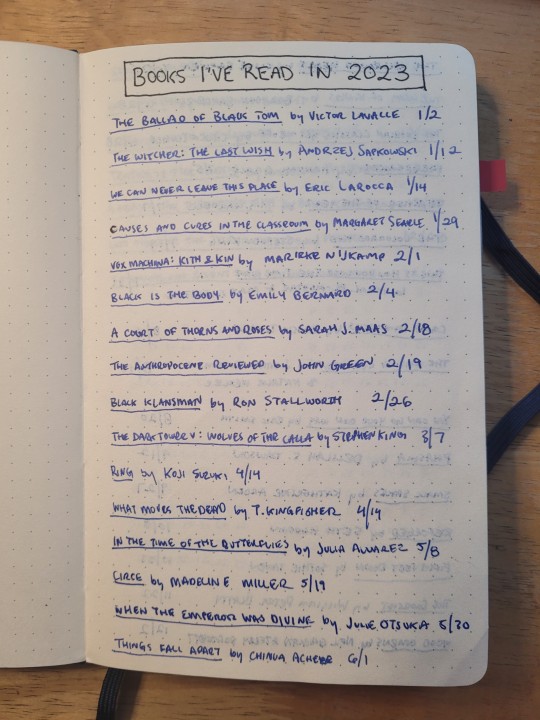
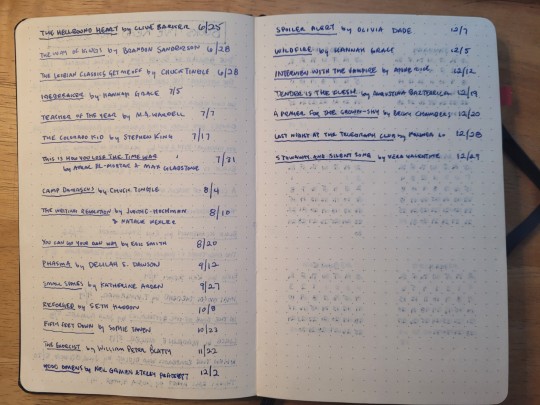
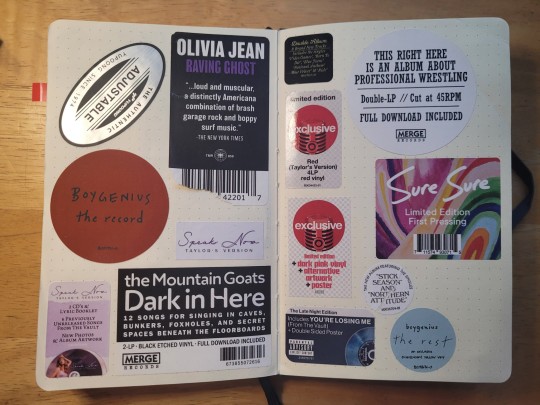

2023 Bullet Journal Cover & Lists
- movies
- books
- physical music stickers
(typed list below cut)
Movies
X (2022) ★★★★★ 1/9
Pearl (2022) ★★★★★ 1/10
Jason X (2001) ★★★ 1/17
X (2022) ★★★★★ 1/26
Pearl (2022) ★★★★★ 2/11
Rosemary's Baby (1968) ★★★★★ 2/11
Harley Quinn: A Very Problematic Valentine's Day Special (2023) ★★★★★ 2/12
Skinamarink (2022) ★★★★ 3/8
Re-Animator (1985) ★★★★ 3/12
Ring (1998) ★★★★★ 3/12
Ju-On: The Grudge (2002) ★★★★ 3/12
I Know What You Did Last Summer (1997) ★★★★ 4/2
Scary Movie (2000) ★★★ 4/3
Dungeons & Dragons: Honor Among Thieves (2023) ★★★★★ 4/5
Everything Everywhere All at Once (2022) ★★★★★ 4/18
Scary Movie 2 (2001) ★★★ 5/3
Scary Movie 3 (2003) ★★ 5/4
The Green Knight (2021) ★★★★★ 5/20
Black Panther: Wakanda Forever (2022) ★★★★ 5/21
Ant-Man and the Wasp: Quantumania (2023) ★★ 6/6
Evil Dead Rise (2023) ★★★★1/2 6/27
Nimona (2023) ★★★★ 7/2
Barbarian (2022) ★★★★ 7/6
Malignant (2021) ★★★★ 7/7
Barbie (2023) ★★★★★ 7/23
Scream VI (2023) ★★★1/2 8/1
Saw (2004) ★★★★ 8/1
Frozen (2010) ★★ 8/2
Resident Evil: Death Island (2023) ★★★★ 8/21
Studio 666 (2022) ★★★★ 9/4
The Exorcist (1973) ★★★★1/2 9/4
Saw II (2005) ★★★★ 9/9
Saw III (2006) ★★★1/2 9/9
Saw IV (2007) ★★★1/2 9/9
Saw V (2008) ★★★ 9/9
Saw VI (2009) ★★★ 9/9
Saw 3D (2010) ★★ 9/9
Jigsaw (2017) ★★★ 9/10
Miss Americana (2020) ★★★★ 9/10
Spiral: From the Book of Saw (2021) ★★1/2 9/17
Spider-Man: Across the Spider-Verse (2023) ★★★★1/2 9/24
Saw (2004) ★★★★1/2 9/25
Saw II (2005) ★★★★1/2 9/26
Dracula (1931) ★★★★ 10/1
Friday the 13th: The Final Chapter (1984) ★★★1/2 10/1
Friday the 13th: A New Beginning (1985) ★★★★ 10/1\
House of 1000 Corpses (2003) ★★★★ 10/8
Friday the 13th (1980) ★★★★1/2 10/13
Taylor Swift: The Eras Tour (2023) ★★★★★ 10/19
Saw VI (2009) ★★★1/2 10/28
Saw 3D (2010) ★1/2 10/29
Saw X (2023) ★★★★1/2 11/6
Saw IV (2007) ★★★1/2 11/20
Saw X (2023) ★★★★1/2 11/20
Terrifier (2016) ★★★1/2 12/4
Hellraiser III: Hell on Earth (1992) ★★ 12/4
Saw V (2008) ★★★1/2 12/4
Terrifier 2 (2022) ★★★1/2 12/11
The Green Knight (2021) ★★★★★ 12/18
Sonic Christmas Blast(1996) ★★1/2 12/22
Black Christmas (1974) ★★★★★ 12/23
Black Christmas (2006) ★★★1/2 12/24
Saltburn (2023) ★★★★ 12/29
Taylor Swift: Reputation Stadium Tour (2018) ★��★★★ 12/30
Books
The Ballad of Black Tom by Victor Lavalle 1/2
The Witcher: The Last Wish by Andrzej Sakowski 1/12
We Can Never Leave This Place by Eric Larocca 1/14
Causes and Cures in the Classroom by Margaret Searle 1/29
Vox Machina: Kith & Kin by Marieke Nijkamp 2/1
Black is the Body by Emily Bernard 2/4
A Court of Thorns and Roses by Sarah J. Maas 2/18
The Anthropocene Reviewed by John Green 2/19
Black Klansman by Ron Stallworth 2/26
The Dark Tower V: Wolves of the Calla by Stephen King 3/7
Ring by Koji Suzuki 4/14
What Moves the Dead by T. Kingfisher 4/14
In the Time of the Butterflies by Julia Alvarez 5/8
Circe by Madeline Miller 5/19
When the Emperor Was Divine by Julie Otsuka 5/30
Things Fall Apart by Chinua Achebe 6/1
The Hellbound Heart by Clive Barker 6/25
The Way of Kings by Brandon Sanderson 6/28
The Lesbian Classics Get Me Off by Chuck Tingle 6/28
Icebreaker by Hannah Grace 7/5
Teacher of the Yearby M.A. Wardell 7/7
The Colorado Kid by Stephen King 7/17
This is How You Lose the Time War by Amal El-Mohtar & Max Gladstone 7/31
Camp Damascus by Chuck Tingle 8/4
The Writing Revolution by Judith C. Hochman & Natalie Wexler 8/10
You Can Go Your Own Way by Eric Smith 8/20
Phasma by Delilah S. Dawson 9/12
Small Spaces by Katherine Arden 9/27
Reforged by Seth Haddon 10/8
Fifty Feet Down by Sophie Tanen 10/23
The Exorcist by William Peter Blatty 11/22
Good Omens by Neil Gaiman & Terry Pratchett 12/2
Spoiler Alert by Olivia Dade 12/7
Wildfire by Hannah Grace 12/5
Interview With the Vampire by Anne Rice 12/12
Tender is the Flesh by Augustina Bazterrica 12/19
A Prayer for the Crown-Shy by Becky Chambers 12/20
Last Night at the Telegraph Club by Malinda Lo 12/28
Stowaway and Silent Song by Vera Valentine 12/29
Physical Music Media:
(this isn't all of the records/CDs I've gotten or listened to this year, but I figured I'd decipher the stickers I put in the book; these are all of the promo stickers on the outside of the plastic wrapping on the releases)
Beat the Champ - the Mountain Goats
Paradise - Lana del Ray
Red (Taylor's Version) - Taylor Swift
What's it Like? - Sure Sure
Did You Know There's A Tunnel Under Ocean Boulevard? - Lana del Ray
Stick Season - Noah Kahan
The Rest - boygenius
Midnights (Late Night Edition) - Taylor Swift
Raving Ghost - Olivia Jean
The Record - boygenius
Speak Now (Taylor's Version) - Taylor Swift
Dark in Here - the Mountain Goats
Bangerz (10th Anniversary Edition) - Miley Cyrus
God Games - the Kills
1989 (Taylor's Version) - Taylor Swift
#mine#studyblr#notes#aesthetic#bujo#bullet journal#bujolife#bujo aesthetic#bujoinspo#bujoblr#bujo list#2023 reap#booklr#books#film
34 notes
·
View notes